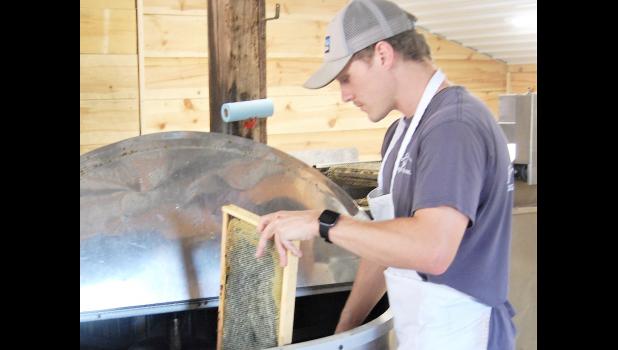How sweet it is!

Third installment in a three-part series. In the first installment we took a look at the Pesch's hobby evolving into commercial business. The second installment explained how Charlie Pesch, the proprietor of Big Dipper Honey taking his bee hives to Texas to take advantage of an early spring and multiplying his hives. In this installment, we look at how honey is made and bottled.
Charlie Pesch seated himself in front of a holding tank that contains 1,000 pounds of fresh honey. Slowly he turns the spigot to open the valve and the natural golden product of his bees begins to flow into a quart jar.
The filled jar is then placed on a table next to the many others he has previously filled; some in jars and others in plastic bottles. A label containing the name of his business is then affixed to the front of each container.
Pesch recently took over an apiary hobby that was started by his father, J.D. several years ago. He has soaked in as much knowledge about honey bees, making honey and running a business as he has time for.
Pesch named his business "Big Dipper Honey" to reflect the seven members of the Pesch family. He designed a logo featuring the Ursa Major constellation because it contains seven stars to reflect the family size.
Pesch harvested 1,000 pounds of honey last year, giving away most of it and selling the rest at local Farmers Markets. His goal this year is to harvest 3,000 pounds.
To increase his volume, he spent a couple of months in Texas, where spring comes earlier, to try and multiply his hives. He went to the Lone Star State with 40 hives and returned in May with twice that many.
"My family really helped a lot this spring," said Charlie. "And now my sister, Ellie, is helping me get the honey bottled."
From hives to bottles
Pesch had hives in four or five locations ("bee yards") last summer. He now has seven different locations between Ghent and Minneota this year.
"The one thing we have noticed and have heard from people is how many more flowers there are in Minneota," Pesch said proudly.
That is a result of his bees taking "road trips" around town and pollinating the flowers and fruit trees.
After the bees make their honey on the frames in the hives, Pesch takes those frames to a large shed that houses the honey-making machines.
Each frame needs to have a crusted cap removed in order to reach the natural honey. Pesch slides each frame in a decapping machine that removes that crust. Once it comes out the other side, Pesch takes each frame and places it in an extractor that holds 60 frames, or 200 pounds of honey.
Once the extractor machine is turned on, the frames are spun inside and centrifugal force pulls the honey off the frame and onto the sides of the extractor. The honey then drains into a clarifier and eventually into the holding tank.
"I have to strain the honey in an 800 micron strainer before it can go into a container," said Pesch. "Sometimes there are little pieces of a bee or something else that you don't want getting into the container. You don't want any visible impurities in the honey."
Big Dipper Honey is available at Brad's Market in Minneota and Columbia Imports in Marshall. Pesch also sells it at Farmers Markets in Minneota, Canby and Marshall.
Bee swarms?
Pesch has had several local people contact him about bee swarms on their property.
"I am more than happy to help out," he said, mentioning that he does not charge for the removal service. "It's more bees for me."
If anyone wants a swarm removed from their residence or business, call Pesch at 612-598-1737.



